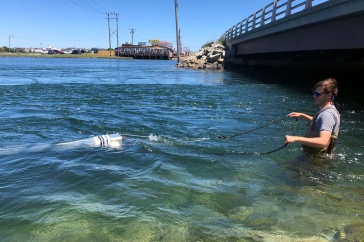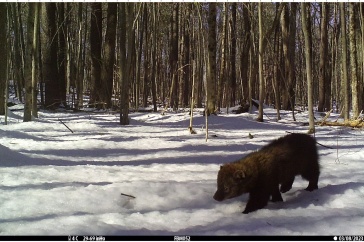 The National Oceanic and Atmospheric Administration (NOAA) states that methane is the second biggest contributor to global warming, after carbon dioxide. NOAA has tracked the amount of methane in our atmosphere since 1983; based on the annual increases in parts per billion (ppb) of methane in the atmosphere, they estimate that there’s 162 percent more methane today in our air than there was during pre-industrial times.
The National Oceanic and Atmospheric Administration (NOAA) states that methane is the second biggest contributor to global warming, after carbon dioxide. NOAA has tracked the amount of methane in our atmosphere since 1983; based on the annual increases in parts per billion (ppb) of methane in the atmosphere, they estimate that there’s 162 percent more methane today in our air than there was during pre-industrial times.
With 280 square miles of freshwater lakes and ponds and over 10,000 miles of rivers and streams in New Hampshire, water is critical to the health, economy and recreation of Granite Staters. However, with aquatic ecosystems annually releasing about half of the methane that enters the atmosphere, New Hampshire water may be playing a bigger role in the environment than previously thought. Recent research from the NH Agricultural Experiment Station (NHAES) has focused on how bodies of water emit greenhouse gases and are incorporated into developing climate change models.
Different aquatic bodies play different roles in the release of methane gas. Wetlands, lakes, and reservoirs all play large roles in releasing methane directly into the atmosphere, primarily through a process known as ebullition, in which methane literally bubbles out of the wetland and enters the atmosphere, contributing to the greenhouse gas effect.
Rivers and streams, however, were historically seen as pipelines for simply moving material between bodies of water. They weren’t viewed as important pieces of the global methane cycle, describes Andrew Robison '21G, a graduate of the Ph.D. program in Earth and Environmental Science at COLSA, former NHAES graduate research assistant, and a post-doctoral scientist in the aquatic biogeochemistry program at École Polytechnique Fédérale de Lausanne (EPFL) in Switzerland. Robison co-authored an article in Frontiers in Environmental Science journal that shows that small streams are sources of methane to the atmosphere and that nearly half of the methane within small streams actually oxidizes – the chemical process of combining with oxygen. The oxidization removes the gas out of the global methane cycle rather than it being emitted to the atmosphere.
“In terms of methane release and the carbon cycle, streams are understudied aquatic ecosystems compared to lakes, reservoirs and wetlands.”
“In terms of methane release and the carbon cycle, streams are understudied aquatic ecosystems compared to lakes, reservoirs and wetlands,” describes Robison. “This is in part because flow makes streams a little more difficult to study than ponds or lakes; spatial variability is more dramatic in streams than in waterbodies that don’t have flow.”
“However, the more we examine streams, the more we understand them to be active in the methane cycle and vents of methane to the atmosphere,” he adds.

Robison and his co-authors measured the methane emissions and soil microbial communities within four streams in New Hampshire and Massachusetts. Samples were collected from the four streams roughly each week and then analyzed at the Trace Gas Biogeochemistry Lab at the UNH Earth Systems Research Center. The microbial communities in the streambeds were analyzed at the UNH Hubbard Center for Genomics to identify the presence of the types of bacteria that create (called methanogens) and oxidize (called methanotrophs) methane.
“Streams are really the next frontier in understanding aquatic methane cycling as we know very little in comparison to lake and wetland methane emissions,” describes Ruth Varner, professor of biogeochemistry in UNH’s Department of Earth Sciences and principal of UNH’s Trace Gas Biogeochemistry Lab. “It is critical for collaborations like this across our research groups to measure methane using common techniques in both the field and laboratory to help us understand the contribution of aquatic ecosystems to atmospheric methane.”
From these samples, the researchers discovered that the streams were dynamic places of methane production and oxidation. However, the flow in streams appears to differentiate how methane cycles in streams compared to lakes and wetlands.
“What happens in streams is that currents are constantly mixing and helping to pull oxygen into them, down near the places in the soil where there is no oxygen and where methane is created through a process called methanogenesis,” describes Wil Wollheim, a station scientist and associate professor at COLSA, and the co-director of the UNH Water Systems Analysis Group. “It’s in these oxygenated layers – just above the soils, where oxygen is being introduced by currents – where microbes called methanotrophs consume the methane, oxidizing the gas and preventing it from being released into the atmosphere.”
Their research also showed that streams are different from wetlands and lakes in that most of the methane that is emitted from streams is not through ebullition, but through diffusion. As a result, the chemical signature of the methane is slightly different. According to Robison, measuring these differences in streams is critical to analyzing their role within the global carbon and methane cycles.
“Methane is a potent greenhouse gas – approximately 30 times as powerful as carbon dioxide. Because aquatic ecosystems are the largest natural source of methane on the planet, we need to really understand the patterns of methane emissions from all aquatic ecosystems.”
“Methane is a potent greenhouse gas – approximately 30 times as powerful as carbon dioxide. Because aquatic ecosystems are the largest natural source of methane on the planet, we need to really understand the patterns of methane emissions from all aquatic ecosystems, including streams, to understand the global methane cycle fully.”
Robison co-authored the paper with Wollheim and assistant professor Jessica Ernakovich, both experimental station researchers in the natural resources and the environment department at UNH, and professor Varner of the earth sciences department at UNH. Additional co-authors included graduate research assistant Paige Clarizia ‘19, ‘20G; postdoctoral researcher Clarice Perryman ‘17G, ‘18G; undergraduate researcher Annie Cotter; and postdoctoral researcher Jessica Mackay.
This material is based on work supported by the NH Agricultural Experiment Station through joint funding form the USDA National Institute of Food and Agriculture (under Hatch awards number 1022476 and 1016134) and the state of New Hampshire. Additional funding for this project comes from the Plum Island Ecosystems LTER NSF Award OCE-1637630, the National Aeronautics and Space Administration Interdisciplinary Science award NNX17AK10G, and the University of New Hampshire College of Life Sciences and Agriculture’s Paine Fund.
Read Dominance of Diffusive Methane Emissions From Lowland Headwater Streams Promotes Oxidation and Isotopic Enrichment in the January 2022 issue of Frontiers in Environmental Science journal.
-
Written By:
Nicholas Gosling '06 | COLSA/NH Agricultural Experiment Station | nicholas.gosling@unh.edu

















































